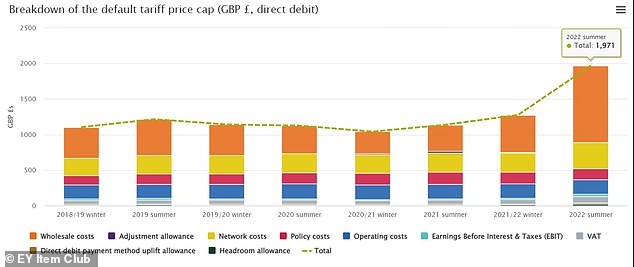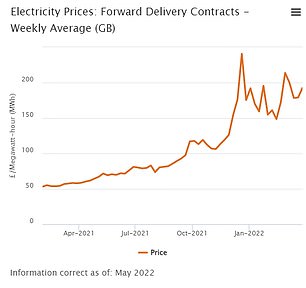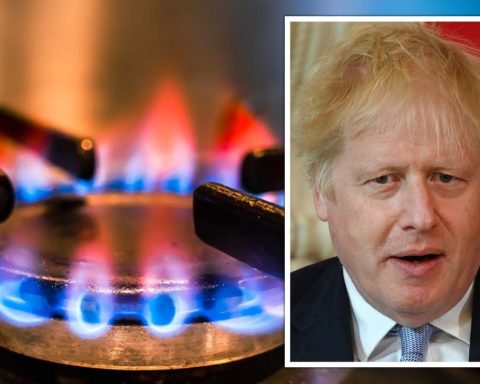Ofgem could soon increase or decrease the energy price cap four times a year, under new plans it claims could help ease the cost of living crisis in the UK.
Under the proposals the cap, which limits how much energy firms can bill their customers, could be reset every three months, rather than every six months, from October.
The regulator said the move would allow customers ‘to benefit much sooner’ when prices begin to fall from their current highs.
This is Money explains how the energy price cap works, and how this potential change could affect customers.

The proposal to increase the frequency of the energy price cap review could mean households can benefit sooner when the overall cost of gas and electricity is expected to fall from 2023
What is the energy price cap?
The energy price cap sets the maximum amount that customers on a ‘default’ tariff - - around 22 million households - can be asked to pay their supplier per unit of electricity.
In April it increased by 54 per cent, raising bills by average of £693 for the typical household from £1,277 to £1,971 per year.
The soaring cost of natural gas has driven energy bills to record highs and led to the collapse of more around 30 energy suppliers.
The price cap can currently be changed every six months and, unless wholesale gas prices start to decrease, is expected to rise again in October.
This will pile further pressure on strained budgets, as households see one of the worst cost of living crises in decades.
Why does Ofgem want t omove the cap more often?
Ofgem said it was discussing the idea of increasing the frequency of the price cap review.
This followed criticism that the present twice-yearly adjustment had contributed to the failure of so many energy suppliers last year.
At the time, the cap was credited with protecting families from the worst rises in energy costs - but it also prevented companies passing on the unprecedented increases to their customers for up to six months, which ultimately contributed to their collapse.
When energy firms collapse, the cost of transferring their customers to new suppliers is passed on to bill payers.
The latest forecasts for the upcoming October review suggests that bills could rise to almost £2,600 - reflecting the impact of Russia’s war in Ukraine for the first time.
Hpwever, Ofgem also says that changing the cap more often should help households after energy prices peak and start to fall, as they will get reductions in their bills sooner.

Rising: Ofgem reviews its price cap every 6 months, and April’s review saw it hit record highs
What could this mean for households’ energy bills?
With the price cap set to rise in October, households are rightfully worried about what this could mean for their already soaring energy bills.
Some households which are not on fixed tariffs have seen their energy bills soar by hundreds of pounds a month.
If the price cap review was made more frequent, it would allow for customers’ energy bills to drop more quickly, once energy prices started to fall back down.
Under the current system, if the energy price cap rises in October, many households could be facing at least six months of sky-high bills, even if the price of gas and electricity dropped in the meantime.
But we don’t know for sure when, or even if, these prices will come down any time soon - and the proposed new system would also allow for more frequent increases if prices continued to rise.
Ofgem said its proposals would allow bills to rise or decline more quickly, but its chief executive said that the next movement would likely be upwards.
A spokesperson said, ‘A more frequent price cap would reflect the most up-to -date and accurate energy prices and mean when prices fall from the current record highs, customers would see the benefit much sooner.
‘This change would also help energy suppliers more accurately predict how much energy they need to purchase for their customers, reducing the risk of further supplier failures which ultimately push up costs for consumers.’


The wholesale cost of gas and electricity, which amounts for the largest portion of the average UK energy bill, has fluctuated as prices remain at an overall high since 2020
What is the expert verdict?
Myron Jobson, senior personal finance analyst at investment platform Interactive Investor, said that the change could make energy bills ‘more palatable’, helping households to budget better, despite initial concerns.
He said: ‘Staying on top of energy bills is becoming a daily battle for many. The recent increase in the energy price cap has pushed many finely crafted budgets to breaking point.
‘With the cost of seemingly everything else also on the up, more regular price rises will be a worry for many.
‘However, smaller but more frequent price changes would be more palatable than less frequent but sharp price hikes for many consumers as it provides greater consistency. It is easier to budget for smaller price hikes than larger ones.
Simon Oscroft co-founder of green energy supplier So Energy, added: ‘Ofgem’s announcement that it is minded to move to a quarterly price cap review rather than bi-yearly is a positive step in reforming the retail market following the wholesale volatility last autumn and this spring.
‘The current bi-yearly cap review leaves customers with huge bill shocks and suppliers exposed to significant volume risks which add cost to all customers.
‘However, even a quarterly cap still exposes suppliers to significant risk and the cost of this ends up on customer bills.
‘Moving to a relative price cap would help reduce risk and cost over the medium term for customers at the same time as ensuring loyalty is not penalised.’
A relative price cap would mean that the Government and regulator would not set a fixed limit on energy bills.
Instead, they would set a limit on the differential between the highest and lowest price charged by each supplier, and suppliers would need to keep their bills within that bracket.
> Are you worried about what the increase in price cap reviews could mean for your energy bills? Get in touch via email: [email protected].
Some links in this article may be affiliate links. If you click on them we may earn a small commission. That helps us fund This Is Money, and keep it free to use. We do not write articles to promote products. We do not allow any commercial relationship to affect our editorial independence.



